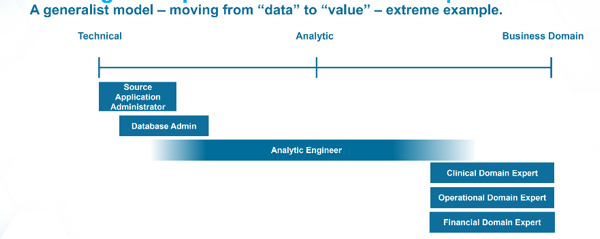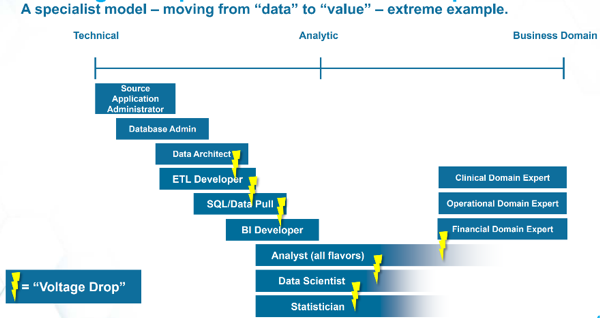Data is everywhere. But without a plan to extract meaning from data and turn insights into action, data can’t impact outcomes. Generating value from data takes work, but it can be done. To create compelling data insights that promote action, health systems can follow three guiding principles for actionable healthcare data analytics as well as hire analysts with seven important skills.
Three principles form the foundation for actionable healthcare data analytics:
1. Balance investments.
2. Hire generalists over specialists.
3. Develop a team that’s highly aligned and loosely coupled.
 Download
Download

Editor’s note: This report is based on a 2018 Healthcare Analytics Summit presentation given by Russ Staheli, SVP, Health Catalyst, entitled, “Data, Insights, Action! Little-Known Principles and Skills for Making Analytics Actionable.”
Data surrounds us. The abundance of data available to healthcare organizations is ripe and ready to be consumed, but many data analysts struggle with knowing how to turn data into insights and insights into action. Often, the problem is too much data and too few insights with even less action. To leverage the wealth of data available, data analysts must generate excitement to glean insights from the data and generate value by converting those insights to action.
The more compelling insights are, the more difficult it becomes not to act on them. So what magic elixir makes data irresistible?
Three little-known principles about data analytics can help organizations extract meaningful, actionable data—and use it to improve outcomes. While these are not the only guiding principles that can lead to successful teams and outcomes, they are three that aren’t talked about frequently but can have a massive impact on a team’s ability to deliver positive outcomes.
Success requires investment. That’s true in life and in healthcare. To use data to its fullest potential, healthcare organizations must invest both in gathering insights and in putting those insights to work for the people they serve every day.
One key to successful data analytics is finding the right balance for this investment. Investing too heavily in analyzing data can lead to focus diffusion—spending time and money that doesn’t provide a full return on investment.
On the other hand, overinvesting in making insights actionable can lead to a loss of focus and wasted effort. And pushing through data too quickly can have catastrophic effects ranging from lost trust to misguided programs that don’t improve outcomes and may even have the opposite effect. Another risk of overinvesting in data actionability is, surprisingly, a lack of insights. Focusing too heavily on one or two insights and ignoring the rest is short-sighted. Thus the mantra: Balance is key.
Understanding whether investments are balanced requires introspection. Can the analytics team identify the three biggest opportunities for improvement within a given focus area (e.g., financial state, patient outcomes)? And can the team show where analytics is actively driving value to a focus area?
If an analytics team can answer those questions within one day, there’s a good chance investments are balanced.
Within healthcare, specialization tends to give patients confidence. Many people feel better when treated by a specialist who spends all day every day working on or studying specific diseases or conditions. A man with brain cancer wouldn’t go to an obstetrician for care, and a pregnant woman wouldn’t have regular prenatal visits with a neurologist. And while there are general practitioners who can and do adeptly treat a plethora of health problems, most refer some of their patients to specialists.
When it comes to data, however, generalization trumps specialization. Why? The short answer is that the generalist model leaves less room for error than the specialist model because fewer people handle the data during the process of moving data to value.
Figures 1 and 2 help illustrate the value of generalists over specialists.


A voltage drop, noted by a yellow lightning bolt, is a place along the continuum where data can get dropped, misinterpreted, or muddied. You can see the potential dangers of a specialist model in the voltage drops alone.
When using the generalist model, there are fewer opportunities for data mismanagement. Other benefits of the generalist model include:
To build a team of generalists, make sure all data analysts (also known as analytics engineers) have seven core analytic skills (described in more detail in the seven skills section below) and additional specialty skills. This image helps illustrate how the generalist model helps cover many skill areas without hiring a specialist for each.
Overall, the generalist model is more effective than the specialist model because the former tends to drive more results with improvement (RWI) involving fewer people.
What is highly aligned; loosely coupled? Sheryl Sandburg, chief operating officer of Facebook, said this concept is the most important thing to come out of Silicon Valley. Ever. It’s a Netflix guiding principle, and it’s embedded it in their culture. In short, highly aligned; loosely coupled means organizations should work toward a team that is highly aligned in their principles and goals but free to accomplish those goals in the way that works best for each person. There are several effective ways to do this:
All those things help build trust, which helps create a cohesive team that’s invested in its work and the organization and helps reduce attrition.
Without data analysts, the sea of healthcare data is just numbers and figures. But when data analysts are well trained and suited for the job, they can create valuable insights, allowing caregivers and others to turn those insights into action.
Analytic engineers have two overarching goals: drive insights and drive value. They are measured on the quantity, quality, clarity, and actionability of the insights they generate from data and the actionability and value of those insights. Ultimately, it’s about providing RWI.
It takes more than SQL skills to excel at data analytics. Developing a team of analytic engineers with strong interpersonal abilities combined with a core skill set is important for writing the right queries that call the right data to get the right insights.
These are the seven core skills analytic engineers need to get the most from data.
There’s an inside joke about data analysts. How can you tell an introverted data analyst from an extroverted data analyst? The extroverted one is looking at your shoes. That’s the stereotype. Data analysts don’t have many interpersonal skills. Fortunately, there are many who defy the stereotype. And those are the people to hire. Interpersonal skills are separated from the other six core skills because they are so important. Without interpersonal skills, a team-first attitude, and the ability and willingness to adapt to change and be flexible, analytic engineers will struggle to accomplish goals and deliver outcomes.
Analytics engineers are most successful when they have the desire and the ability to interact with colleagues, both inside and outside the organization. Being able to communicate clearly and to engage others is an invaluable skill. When working with hospitals and healthcare systems, analytic engineers must talk with physicians and C-suite executives, asking questions to gain a deep understanding of the organizations they work with. They also need to be engaging and tell compelling stories with data. Those conversations will help inform their queries, which is how they gather meaningful insights that ultimately lead to actions that can improve outcomes. They must work as part of a larger team all driving toward a common goal. They also need to be flexible and adaptable to navigate the ever-changing healthcare landscape.
Machines are smart, but without skilled analytic engineers, the smartest machines in the world won’t produce the type of results needed to transform healthcare.
In addition to interpersonal skills and adaptability, analytic engineers should have the following six skills. These core skills fall into two basic categories: overarching skills and technical skills.
In addition to the above skills, all analytic engineers should be fluent in the following technical skills. These skills help engineers understand the flow, availability, and usability of data.
Visualization principles can help analysts take presentations about data insights to the next level and make data evermore compelling:
There are some great thought leaders in the visualization space, including Edward Tufte. His book Visual Display of Quantitative Information provides a wealth of information about the theories behind visualization principles. Stephen Few is another leader worth checking out.
Quality improvement principles are important as well. They help create a framework for solving problems and improving systems, and they help ensure work has an impact and is sustainable.
In the future, machine learning, quality improvement principles, and visualization principles will become more and more important. But no matter how much healthcare changes and technology advances, nothing will surpass the need to live by the guiding principles that make analytics actionable. And no matter how smart technology gets, it isn’t likely to replace analytics engineers with the seven skills covered here.
Balance investments, hire and train generalists with interpersonal skills, and engage, empower, and align the team to meet goals and make insights actionable. Putting the three guiding principles into action then developing a team of analytics engineers with the seven core skills will go a long way toward actionable data. Data is just data if it doesn’t spark action. And following these principles will go a long way toward making data valuable – and actionable.
Would you like to learn more about this topic? Here are some articles we suggest: